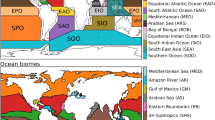Abstract
Two typical satellite sea surface temperature (SST) datasets, from the Multi-functional Transport Satellite (MTSAT) and Tropical Rainfall Measuring Mission Microwave Imager (TMI), were evaluated for the East China Sea, Yellow Sea, and Bohai Sea throughout 2008. Most monthly-mean availabilities of MTSAT are higher than those of TMI, whereas the seasonal variation of the latter is less than that of the former. The analysis on the one-year data shows that the annual mean availability of MTSAT (61%) is greater than that of TMI (56%). This is mainly because MTSAT is a geostationary satellite, which achieves longer observation than the sun-synchronous TMI. The daily availability of TMI (28%–75%) is more constant than that of MTSAT (9%–93%). The signal of infrared sensors on MTSAT is easily disturbed on cloudy days. In contrast, the TMI microwave sensor can obtain information through clouds. Based on in-situ SSTs, the SST accuracy of TMI is superior to that of MTSAT. In 2008, the root mean square (RMS) error of TMI and MTSAT were 0.77 K and 0.84 K, respectively. The annual mean biases were 0.14 K (TMI) and −0.31 K (MTSAT). To attain a high availability of SSTs, we propose a fusion method to merge both SSTs. The annual mean availability of fusion SSTs increases 17% compared to MTSAT. In addition, the availabilities of the fusion SSTs become more constant. The annual mean RMS and bias of fusion SSTs (0.78 K and −0.06 K, respectively) are better than those of MTSAT (0.84 K and −0.31 K).
Similar content being viewed by others
References
Bao X W, Wan X Q, Gao G P et al. 2002. The characteristics of the seasonal variability of the sea surface temperature field in the Bohai Sea, the Huanghai Sea and the East China Sea from AVHRR data. Acta Oceanologica Sinica, 24(5): 125–133. (in Chinese with English abstract)
Borron C N, Kara A B. 2006. Satellite-based daily SSTs over the global ocean. Geophysical Research Letters, 33: L15603, http://dx.doi.org/10.1029/2006GL026356.
Donlon C J, Nykjaer L, Gentemann C. 2004. Using sea surface temperature measurements from microwave and infrared satellite measurements. INT. J. Remote Sensing, 25(7–8): 1 331–1 336.
Fan H Y, Teng J, Guan L et al. 2009. Validation of sea surface temperature from NOAA/AVHRR in the Northwest Pacific. Marine Forecasts, 26(2): 7–14. (in Chinese with English abstract)
Guan L, Kawamura H. 2003. SST availabilities of satellite infrared and microwave measurements. J. Oceanography, 59: 201–209.
Gentemann C L, Donlon C, Stuart-Menteth A et al. 2003. Diurnal signals in satellite sea surface temperature measurements. Geophysical Research Letters, 30(3): 1 140, http://dx.doi.org/10.1029/2002GL016291.
Gentemann C L, Wentz F J, Mears C A et al. 2004. In situ validation of Tropical Rainfall Measuring Mission microwave sea surface temperature. J. Geography Research, 109: C04021, http://dx.doi.org/10.1029/2003JC002092.
Guan L, Kawamura H. 2004. Merging satellite infrared and microwave SSTs: methodology and evaluation of the new SST. J. Oceanography, 60: 905–912.
Lee M A, Chang Y, Sakaida F et al. 2005. Validation of satellite-derived sea surface temperatures for waters around Taiwan. TAO, 16(5): 1 189–1 204.
Li N, Sun F Q, Zhang C Y et al. 2006. A primary validation of remote AVHRR SST in Taiwan Strait and its vicinity. Journal of Xiamen University (Natural Science), 45(3): 383–387. (in Chinese with English abstract)
Qiu C H, Wang D X, Kawamura H et al. 2009. Validation of AVHRR and TMI-derived sea surface temperature in the northern South China Sea. Continental Shelf Research, 29: 2 358–2 366.
Reynolds R W, Gentemann C L, Wentz F J. 2004. Impact of TRMM SSTs on a climate-scale SST analysis. J. Climate. 17(8): 2 938–2 952.
Stammer D, Wentz F J, Gentemann C L. 2003. Validation of microwave sea surface temperature measurements for climate purposes. J. Climate, 16(1): 73–87.
Sun F Q, Zhang C Y, Shang S P et al. 2007. Primary validation of AVHRR/MODIS/TMI SST for part of the Northwest Pacific. Journal of Xiamen University (Natural Science), 46: 1–5. (in Chinese with English abstract)
Udaya B T V S, Rahman S H, Pavan I D et al. 2009. Comparison of AMSR-E and TMI sea surface temperature with Argo near-surface temperature over the Indian Ocean. International Journal of Remote Sensing, 30: 2 669–2 684.
Wang D X, Zhang Y, Zeng L L et al. 2009. Marine meteorology research progress of China from 2003 to 2006. Advances Atmospheric Sciences, 26: 17–30.
Wentz F J, Gentemann C, Smith D et al. 2000. Satellite measurements of sea surface temperature through clouds. Science, 288: 847–850.
Zeng L L, Shi P, Liu W T et al. 2009. Evaluation of a satellitederived latent heat flux product in the South China Sea a comparison with moored buoy data and various products. Atmospheric Research, 94: 91–105.
Zhou W F, Zhang Y G. 2008. Error characteristics analysis of sea surface temperatures retrieved from MTSAT satellite using ARGO data. Transactions of Oceanology and Limnology, 4: 1–6. (in Chinese with English abstract)
Author information
Authors and Affiliations
Corresponding author
Additional information
Supported by the Open Fund of the Key Laboratory of Ocean Circulation and Waves, Chinese Academy of Sciences (No. KLOCAW1010), the Knowledge Innovation Program of Chinese Academy of Sciences (No. KZCX1-YW-12-04), the National High Technology Research and Development Program of China (863 Program) (Nos. 2007AA092202, 2008AA121701)
Rights and permissions
About this article
Cite this article
Wu, Y., Shen, H., Cui, X. et al. Evaluation and fusion of SST data from MTSAT and TMI in East China Sea, Yellow Sea and Bohai Sea in 2008. Chin. J. Ocean. Limnol. 30, 697–702 (2012). https://doi.org/10.1007/s00343-012-1176-x
Received:
Accepted:
Published:
Issue Date:
DOI: https://doi.org/10.1007/s00343-012-1176-x




